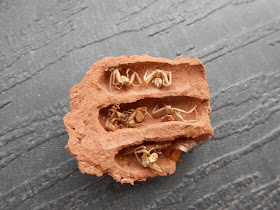There are some chores that one neglects until the situation becomes so bad it can no longer be ignored. Sigh. Such is the case with cleaning the area just outside our laundry room door. This is a covered porch that is enclosed on 3 sides. The nice thing about it being enclosed on 3 sides is that it is shady and is protected from the weather. Therefore, it is a good area for the dogs to take refuge in on days that we have to be gone and they have to be left outside most of the day.
The bad thing about it being enclosed on 3 sides is that leaves and grass and other wind-blown debris collects in the corners and around the trash cans and other "stuff" we have stored there. So, once or twice a year, I get the broom and tackle the task. This involves moving all the "stuff". Today, when I moved a set of shelves, I found the following.
You may recognize these as mud dauber nests. Basically, they are built by a type of wasp called a mud dauber. These wasps range from solid black to blue-black to yellow and black. They are not aggressive and, even when they sting, it is usually not bad. They are, however, a nuisance in that they build these mud nests on walls, like this, and it makes quite a mess when they are removed.
The wasps collect small balls of mud with which they construct the nests. The nests are very hard when they dry. Inside each mud nest are chambers where the eggs are laid. One egg is laid in each chamber and then sealed with mud. When the young wasps emerge, they are somehow able to break their way out of these enclosures, thus leaving a small round hole in the end.
Oh, did I forget to mention that before the wasp seals each chamber, it catches small spiders which it paralyzes with its sting and seals a couple of spiders inside to provide food for the egg when it hatches. Here are the ghostly remains of the unfortunate spiders that ended up fodder for this nest.
Usually, the outer cover of the pupated wasp is left behind as well, such as the following.
Today, I found a couple of young wasps that were still encased inside the nest. Here is one of them.
The life-cycle of these creatures is fascinating, but I'd rather not think about the poor spiders!





Thank you for your post - I found one of these on the inside of my front door just a little while ago. I recognized it as a possible mud dauber nest (it only had a single cavity/channel) and was surprised to find three spiders inside. After knocking it off the door frame, I noticed the spiders - one was still alive (barely) and the other two seemed dead. It was definitely something new to me!
ReplyDelete